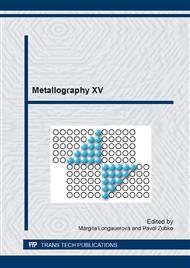p.235
p.239
p.243
p.247
p.251
p.257
p.263
p.269
p.275
Research through the Stationary Specimen Method of the X20Cr13 Stainless Steel Used for Hydraulic Pumps
Abstract:
This paper presents the cavitation erosion research through the stationary specimen method of the X20Cr13 martensitic stainless steel. Actual research involves a number of 4 different tests for this material and the comparison between these experimental tests is highlighted by the images and graphs forwarded in the paper. All research was done using vibratory apparatus composed from electro-acoustic piezo-converter, acoustic transformer, a titanium sonotrode and the ultrasonic generator DG-2000. The mass loss of the martensitic stainless steel samples was measure with special digital balance.
Info:
Periodical:
Pages:
251-256
Citation:
Online since:
April 2014
Price:
Сopyright:
© 2014 Trans Tech Publications Ltd. All Rights Reserved
Share:
Citation:


